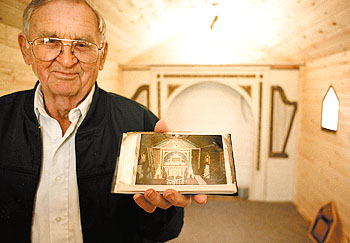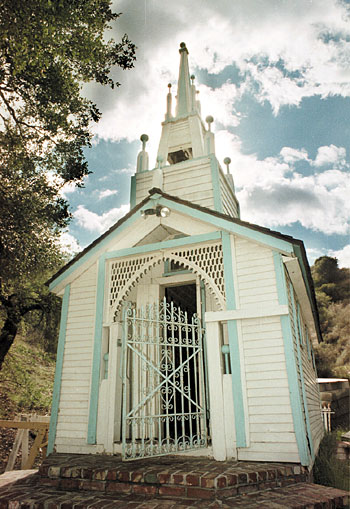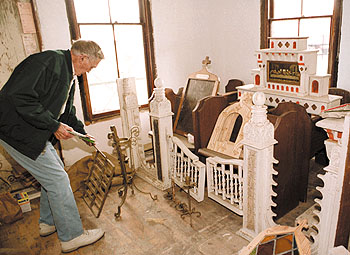
Ramona Chapel Gets a Facelift

Historical Society board member Allan Howe shows an old picture-postcard of the interior of the original Ramona Chapel at Rancho Camulos. Photo by Nathan Caswell/The Signal
|
|
By Margie Anne Clark
Signal Staff Writer
Tuesday, February 27, 2001
ike a princess from heaven, the historic Ramona Chapel in Newhall once stood as beacon of beauty in the midst of an emerging City of Angels from the early 1920s to the early '60s. But the Ramona Chapel has seen better days since its 1963 move from its original home in Culver City to its second home in Mint Canyon, and finally to its current abode in 1987 — in Heritage Square at Historic Junction Historic Park inside William S. Hart Regional County Park.
While time has not diminished its allure, the tiny chapel has been need of a face-lift to restore the interior to its original beauty for all the world to see.
With the help of Valencia resident Allen Howe, that bit of cosmetic magic is in the process of becoming a reality. Howe, with the help historical society funding and few friends, has taken it upon himself to do something about it. The agile 83 year-old recently began the delicate process of restoring the chapel, one piece at time.
Howe joined the Santa Clarita Valley Historical Society in 1996 and now serves on the board of directors. He has lived in the Santa Clarita Valley for more than 28 years.
A retired plumber, Howe enlisted the help of his contractor friend Bob Cumming, and his grandson, A.J. Denogian, 27, to help with the arduous task of moving the heavy pews and alter pieces from the tiny structure.
The Ramona Chapel has been used as a movie set by John Wayne, and has been visited by notables such as Wyatt Earp, Will Rogers, Joan Crawford and many other early stars of the silver screen. It was in this chapel that Gary Cooper was inducted into the Sioux Nation.
"Our plan is to make it look just like it did before," Howe said. "What we're hoping to do is make the building presentable enough to take tour groups through. ... The nice part about doing this is finishing it and making it look like it did in its original state."
In addition to restoring the chapel, Howe would like to see all of the historic buildings fully restored.
"Eventually we would like to take tours through here all of the time," he said.

The Ramona Chapel at Heritage Junction Historic Park was built in 1926 for Robert E. Callahan's Mission Village attraction in Culver City. Photo by Nathan Caswell/The Signal
|
|
The quaint little Ramona Chapel is no stranger to tours. It was built in the early 1920s for Robert E. Callahan, an early silent screen actor and author of novels centering around Native American culture. From 1926 the early 1960s, Callahan, operated an amusement park-like attraction called Callahan's Mission Village in Culver City. The historically themed park featured teepees and other recreated pieces of early California history, including the Ramona Chapel and a schoolhouse.
Callahan gave up the Culver City property to make way for the Santa Monica Freeway in 1963 and moved his base of operations to Sierra Highway. Following Callahan's death, his widow donated the Ramona Chapel, the Red Schoolhouse and other memorabilia from Callahan's Old West to the SCV Historical Society.
The chapel was designed by Carrie Jacobs Bond, a composer who wrote "I Love You Truly," and "The End of a Perfect Day." The design was based on the original chapel on the site of historic Rancho Camulos, located near Piru. It said to have been made from ruins of old Spanish missions. Callahan's widow, Marion Callahan, aka Kitty Kelly, has said her late husband assembled the chapel out of bits and pieces of old churches said to be as old as 200 years. A 48-cup brass candelabra was donated by Bond.
The original, fictional Ramona Chapel was made famous by early Indian activist, Helen Hunt Jackson, who visited Rancho Camulos. Her 1884 novel, "Ramona," is loosely based on the people and events she encountered during her brief stay at Camulos in 1882.
Out of this brief visit sprang the first novel written about the region. It was Jackson's intention to supply readers of her book with an appreciation of the plight of California Indian, as illustrated by the trials and tribulations of the fictional Indian girl, Ramona, whose Indian heritage was kept secret from her by her adopted mother.
The story became one of the most widely read American novels of the time. It was this novel which firmly established the Mission legend in Southern California.
Although Rancho Camulos was well known among Californians for the accomplishments of three generations of Del Valles in both the political and agricultural history of the state, it is perhaps best recognized beyond California as the "Home of Ramona."
The historic ranch was the family home of Ygnacio del Valle, who owned most of the Santa Clarita Valley following the Mexican Revolution, freeing Mexico, including California, from Spain.
Rancho Camulos was founded in 1853 out of part of the 48,612 acre Rancho San Francisco, granted in 1839 to Ygnacio's father Antonio, majordomo and administrator of Mission San Fernando. Camulos was located at the western boundary of the rancho and was originally a Tataviam Indian village. The San Fernando Mission used the Santa Clarita Valley as early as 1804 for raising small animals and crops grown by the Native Americans.
The "Ramona myth" was perpetuated by D.W. Griffith's silent motion-picture version of "Ramona" starring Mary Pickford, and was filmed at Camulos and Piru during a two-day shoot on April 1 and 2, 1910. The one-reeler was billed as the Biography Co.'s "most elaborate and artistic movie yet filmed." The chapel, the adobe and patio and the nearby mountains were all used as backdrops

Howe stores fixtures from the chapel in the Newhall Ranch House during the chapel's renovation. Photo by Nathan Caswell/The Signal
|
|
The Ramona myth played a key role in establishing a regional identity for Southern California during the time when the West was struggling to establish an historical and cultural legitimacy separate but comparable with the East. As early as the 1870s, artists and photographers began to recognize and document the romantic ruins of the California missions. By the 1880s the colonial architecture of the Southwest was deeply etched upon the national imagination, sparking a local preservation movement directed toward the restoration of the mission churches, and later a revival of the mission architectural style itself. Jackson's novel "Ramona" served to generate interest in the physical place and and its people into a cohesive, if highly romanticized, whole.
This rediscovery of California's picturesque colonial history coincided with the great railroad boom of 1886-87. Rancho Camulos became not only a tourist mecca in and of itself, but also a symbol of California's colonial past in both reality and in fiction. Jackson's novel served to fire the collective imagination of the American public to an extent that it prompted Americans to move in vast numbers from east to west, with expectations of discovering the fabled land of Ramona.
Now, thanks to the efforts of Howe and the SCV Historical Society, new generations of visitors can come and be inspired by the symbolism and rich history of the Ramona Chapel.
"We hope that lots of children will come up and visit the chapel and the other historic buildings," Howe said. "I've enjoyed working on the chapel a little bit at a time and it's been a very worthwhile project."
For more information about the Ramona Chapel and the Historical Society, call 254-1275 or visit scvhs.org.
©2001, THE SIGNAL · USED BY PERMISSION · ALL RIGHTS RESERVED.
|


